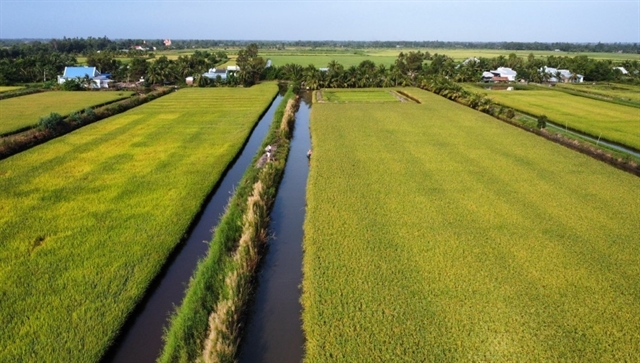 Society
Society

 |
| Shrimp-rice fields in the Cửu Long (Mekong) Delta province of Bạc Liêu. – VNA/VNS Photo |
MEKONG DELTA – Farmers in the Cửu Long (Mekong) Delta who have adopted the shrimp-rice farming model are earning high profits because of high rice yields and prices.
Under the model, they grow rice in the rainy season and farm shrimp in the dry season in the same fields, or both simultaneously.
They do this on around 162,000ha, mostly in coastal provinces, and the model is environment-friendly because farmers use few chemicals.
With 62,500ha, Kiên Giang Province is the leader, and is followed by Cà Mau Province (46,000ha) and Bạc Liêu Province (40,000ha).
The model was first developed by farmers more than 30 years ago, and authorities have since encouraged them to expand it since it is sustainable and has helped many escape poverty.
Farmers in Bạc Liêu Province are getting a bumper rice harvest because of the favourable weather.
Lê Văn Liêm in the province’s Phước Long District planted one hectare of BL9 rice, a fragrant variety, and got a high yield of 10 tonnes.
He also raised giant river prawn and other creatures to earn a total profit of VNĐ150 million ($6,000) this harvest, he said.
Farmers say though shrimp prices are down this year, they still make high profits because of high rice prices.
Nguyễn Văn Vẹn in Phước Long District’s Phong Thạnh Tây Commune said he would only harvest his rice after two weeks but a trader had bought his crop for a record VNĐ11,500 (46 US cents) a kilo.
Farmers in the district have harvested more than 3,000ha of their 15,000ha of shrimp-rice farms so far.
Trần Văn Liêm, deputy chairman of its People’s Committee, said they had rice yields of 8-10 tonnes per hectare and giant river prawn yields of 250-350kg.
In Cà Mau Province’s Thới Bình District, farmers are harvesting giant river prawn and traders are buying them for VNĐ80,000 - 90,000 ($3.2-3.6)a kilo.
Nguyễn Hoàng Lâm, head of the district Bureau of Agriculture and Rural Development, said: “The markets for the district’s giant river prawns are mostly in HCM City, Cần Thơ and Bình Dương and Đồng Nai provinces, and so demand is steady.”
Thới Bình is Cà Mau’s largest giant river prawn breeding district with 14,000ha under shrimp-rice.
Further development
The delta’s coastal provinces are implementing various measures to develop the shrimp-rice model, including through organic farming.
Bạc Liêu Province is enhancing linkages between farmers and companies to develop value chains for the model, and is developing co-operatives that act as a link.
It has established a shrimp-rice farming co-operative alliance with 21 co-operatives to ensure production efficiency.
It has helped co-operatives participate in fairs and trade promotions to expand their markets.
Bạc Liêu aims to increase its shrimp-rice farming area to 43,000ha by 2025.
In Kiên Giang Province, An Biên is the province’s major shrimp-rice farming district with 25,000-27,000ha.
Lê Văn Khanh, head of its Bureau of Agriculture and Rural Development, said the district was expected to increase the area to 29,000ha this year.
The coastal provinces have also invested in irrigation projects to develop the model.
In Cà Mau Province, Nguyễn Việt Khái, chairman of Lợi An Commune in Trần Văn Thời District, said shrimp-rice farmers had enjoyed high yields this year because the commune irrigation system had got a complete makeover and stores more water.
Bạc Liêu Province has invested hundreds of billions of đồng to build irrigation systems and embankments to proactively regulate its water resources.
In Giá Rai City’s Phong Thạnh A Commune, it has invested VNĐ114 billion ($4.6 million) in building sluices and an embankment system around 3,000ha of shrimp-rice farms.
Đỗ Minh Thắng, chairman of the city People’s Committee, said: “At first farmers were reluctant to adopt the shrimp-rice farming model, but many did so after seeing its effectiveness.”
As a result, the city’s shrimp-rice farming area had increased from 3,000ha initially to more than 7,000ha now, he added. – VNS